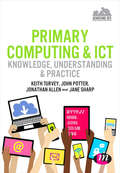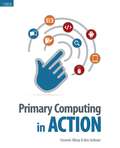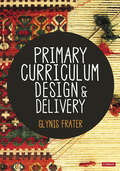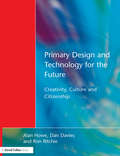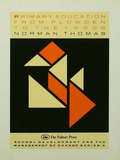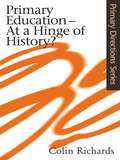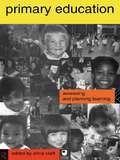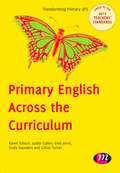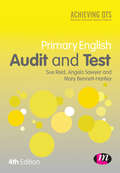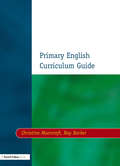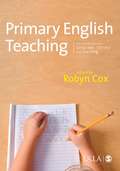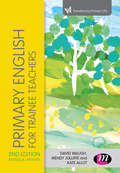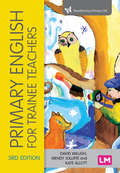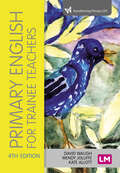- Table View
- List View
Primary Computing and Digital Technologies: Knowledge, Understanding and Practice (Achieving QTS Series)
by Jonathan Allen Keith Turvey Jane Sharp Dr John Potter Jeremy BurtonWhat do you need to know to teach computing in primary schools? How do you teach it? This book offers practical guidance on how to teach the computing curriculum in primary schools, coupled with the subject knowledge needed to teach it. This Seventh Edition is a guide to teaching the computing content of the new Primary National Curriculum. It includes many more case studies and practical examples to help you see what good practice in teaching computing looks like. It also explores the use of ICT in the primary classroom for teaching all curriculum subjects and for supporting learning in every day teaching. New chapters have been added on physical computing and coding and the importance of web literacy, bringing the text up-to-date. Computing is both a subject and a powerful teaching and learning tool throughout the school curriculum and beyond into many areas of children’s learning lives. This book highlights the importance of supporting children to become discerning and creative users of digital technologies as opposed to passive consumers.
Primary Computing and ICT: Knowledge, Understanding and Practice
by Jonathan Allen John Potter Ms Jane Sharp Keith TurveyThis popular text for primary trainees in teaching primary ICT has been updated in line with the new computing curriculum. What do you need to know to teach ICT and computing in primary schools? How do you teach it? This book provides practical guidance on how to teach ICT and the computing curriculum in primary schools alongside the necessary subject knowledge. It explores teaching and learning with applications and technologies, addressing the role of the professional teacher with regards to important issues such as e-safety. This Sixth Edition is updated in line with the new curriculum for computing. It includes new material on how to integrate programming and computational thinking and explores how to harness new tools such as blogging and social media to enrich learning and teaching. Written in an accessible way, it will help trainees to develop confidence in their own approach to teaching. ICT and computing is both a subject and a powerful teaching and learning tool throughout the school curriculum and beyond, into many areas of children's learning lives. This text highlights the importance of supporting children to become discerning and creative users of technology as opposed to passive consumers.
Primary Computing in Action
by Ben Sedman Yasemin AllsopPresenting practical ideas that support teachers and trainees with the planning, implementation and assessment of the 2014 Primary Computing Curriculum. Demonstrating how freely available apps and web-based applications, programmes for PCs and Macs, can be used creatively to design innovative and engaging activities in the Early Years, Key Stages 1 and 2. Covering all aspects of the 2014 primary curriculum, including computer science, digital literacy and information technology. Includes both plugged and unplugged activities.
Primary Computing in Action
by Ben Sedman Yasemin AllsopPresenting practical ideas that support teachers and trainees with the planning, implementation and assessment of the 2014 Primary Computing Curriculum. Demonstrating how freely available apps and web-based applications, programmes for PCs and Macs, can be used creatively to design innovative and engaging activities in the Early Years, Key Stages 1 and 2. Covering all aspects of the 2014 primary curriculum, including computer science, digital literacy and information technology. Includes both plugged and unplugged activities.
Primary Curriculum Design and Delivery
by Glynis FraterThis is a practical guide for school leaders and teachers who have responsibility for designing and delivering a sequenced, knowledge-rich and skills-focused primary curriculum. It considers the elements that underpin a high-quality curriculum and how to create a sequential learning experience for pupils across the primary phase. It explores a range of practical tools and techniques that can support staff to build a cohesive curriculum where pupils build on their learning from year to year with high-quality outcomes for all learners, whatever their starting point. Key topics include: How to create a whole school curriculum strategy that builds on prior learning and ensures knowledge and skills across a range of subjects Creating opportunities for pupils to make connections across their learning How learning is sequenced from early years to the end of Year 6 Identifying opportunities for pupils to deepen their competence in English, mathematics and across all the foundation subjects Glynis Frater is the founder and a director of Learning Cultures. She has taught across both the primary and secondary phases of education and has led professional development on planning and delivering the primary curriculum.
Primary Curriculum Design and Delivery
by Glynis FraterThis is a practical guide for school leaders and teachers who have responsibility for designing and delivering a sequenced, knowledge-rich and skills-focused primary curriculum. It considers the elements that underpin a high-quality curriculum and how to create a sequential learning experience for pupils across the primary phase. It explores a range of practical tools and techniques that can support staff to build a cohesive curriculum where pupils build on their learning from year to year with high-quality outcomes for all learners, whatever their starting point. Key topics include: How to create a whole school curriculum strategy that builds on prior learning and ensures knowledge and skills across a range of subjects Creating opportunities for pupils to make connections across their learning How learning is sequenced from early years to the end of Year 6 Identifying opportunities for pupils to deepen their competence in English, mathematics and across all the foundation subjects Glynis Frater is the founder and a director of Learning Cultures. She has taught across both the primary and secondary phases of education and has led professional development on planning and delivering the primary curriculum.
Primary Design and Technology for the Future: Creativity, Culture and Citizenship
by Dan Davies Alan Howe Ron RitchieThis is a challenging new book for primary teachers interested in developing their teaching of Design & Technology, subject leaders in D&T, and for student teachers choosing this as their specialty. It will also appeal to in-service providers and LEA advisory staff. Children's creativity, cultural development and citizenship are important but currently underdeveloped in primary education. This book uniquely focuses on how these aspects can be emphasized in the teaching of Design and Technology. The National Curriculum has the potential to bring creativity, cultural development and citizenship into the mainstream and the authors show the considerable extent to which D & T, integrated with other curriculum subjects, can contribute to realizing these goals. There are examples throughout of best current practice showing how such ideas have been implemented.
Primary Design and Technology: A Prpcess for Learning
by Ron RitchieDesign and Technology involves children learning through processes that include identifying needs and opportunities, generating and developing ideas, planning, making and evaluating. The second edition fully reflects the latest revisions in the National Curriculum and links with other curricular changes in the intervening years. Specific links are made to the National Strategies for Literacy, Numeracy and ICT; to the National Standards for Subject Leaders; to Science and the other foundation subjects; to the QCA Scheme of Work for D & T; and to new initiatives in citizenship and creativity.
Primary EAL Provision: Getting it Right in a Week (Getting it Right in a Week)
by Kirsty AndersonAre you confident in your understanding of the significant challenges that EAL pupils face? Do you have a range of teaching strategies to address their needs? Are your EAL learners making the required progress in their lessons? This text provides you with tried and tested strategies to help you develop effective pedagogy for learning and progression with a range of different EAL pupils. It includes both immediate measures and handy tips as well as long-term strategies to embed into your teaching. Designed to be read over a week, the book is divided into seven concise chapters that will help you build a rich context with integrated and effective teaching for all your EAL pupils.
Primary Education From Plowden To The 1990s (School Development And The Management Of Change Ser. #Vol. 4)
by Norman ThomasThe Plowden Report delivered high ambitions for more equitable treatment of the under-fives and intended to allow parents and children more influence. Examining how these recommendations have worked in practice, this volume considers changes due to the 1988 Act.
Primary Education Voices
by Matt RobertsOver the past two years, the Primary Education Voices podcast has welcomed dozens of inspirational educators with a variety of roles across primary education to share what they are passionate about. This book gives some of these educators the chance to discuss their ideas, research and reflections in a more in-depth manner to help the reader reflect more deeply about their own practice. This publication is a collation of writing of incredible philosophies, resources and ideas from primary practitioners, for primary practitioners. Engaging chapters cover a wide range of topics for the contributors of this book to share: from developing the right ethos and culture in your school or classroom, to considering how to make your curriculum more rich and inclusive, to considering how to look after your own well-being and vitality in the role of a primary educator. Within each chapter, you will hear from a number of contributors and be given the space to reflect on what they have shared, along with some thought-provoking questions to prompt you on how to adapt and refine your practice. These ideas and insights will be essential to all who work within the primary sector including trainees, early career teachers and middle and senior leaders, as well as all those who support and consult with these individuals who seek to change and improve their practice.
Primary Education at a Hinge of History (Primary Directions Ser.)
by Colin RichardsPrimary education is currently at the centre of political attention. Reform is constantly under consideration, though the leading proponents of reform are often far removed from the classroom and the world of hard-pressed, demoralised primary teachers. Colin Richards rectifies this by communicating the big picture of primary school culture. He takes the world of the primary school since Plowden (1967) and traces perennial and emergent issues - the issues that need to be understood in order to make a difference to the future of primary education. Through constructive criticism of the national curriculum, OFSTED, ITT and teaching methodology the book will influence and improve the understanding of policy makers, headteachers, governors and teachers and students.
Primary Education: Assessing and Planning Learning
by Anna CraftThis wide ranging sourcebook draws together a range of recent and specially commissioned pieces which examine how policy development and research findings have influenced planning and assessing learning for young children. Topics covered include standards, quality control, league tables, teacher and performance assessment. It also looks at the enabling of learning, focusing on authentic activity and learning, implicit values, the role of learner choice and classroom management. The book also raises which will effect assessing and planning learning into the next century, and sets an agenda for reform and development including teacher training, funding of primary education, early years education and entitlement in primary school.
Primary Education: The Key Concepts (Routledge Key Guides)
by Denis HayesPresenting a balance of theoretical insight and practical advice, this text is a clear and accessible guide to the key issues relating to primary education. Alphabetically arranged and fully cross-referenced to ensure ease of use, entries include both curriculum specific terms, as well as those that are more generic, such as: assessment objectives coping strategies differentiation behaviour special needs time management. Written by an experienced teacher and lecturer, this is a concise yet comprehensive text that takes into account the everyday realities of teaching. Readable and user-friendly, it is a first-class resource for the primary practitioner at all levels.
Primary English
by Jane Medwell David Wray Hilary Minns Vivienne Griffiths Elizabeth CoatesThe 6th edition of this popular core text provides the essential teaching theory and practice for primary English. It promotes effective teaching through secure pedagogical knowledge, covering the key skills of planning, monitoring and assessment and class management, and relating these specifically to primary English. This 6th edition is linked to the 2012 Teachers' Standards. With full coverage of the theory and practice required for effective and creative English teaching, this text is an essential guide for all trainees working towards QTS. Throuhgout, practical guidance and features support trainees to translate this learning to the classroom, embed ICT in their lessons and to understand the wider context of their teaching. Trainees will find it helpful to use this book alongside Primary English Knowledge and Understanding. About the Achieving QTS series All the books in this successful series support trainees through their initial teacher training and guide them in the acquisition of their subject knowledge, understanding and classroom practice. All new titles within the series link to the 2012 Teachers' Standards and take into accont recent changes in Initial Teacher Training. Jane Medwell is an Associate Professor of Education at the Institute of Education, University of Warwick. David Wray is Professor of Literacy Education at the Institute of Education, University of Warwick. Hilary Minns co-ordinates primary English courses in the Institute of Education, University of Warwick. Elizabeth Coates works in the Institute of Education, University of Warwick, where she co-ordinate Early Years courses. Vivienne Griffiths is Professor of Education at Canterbury Christ Church University.
Primary English
by Jane MedwellThe essential subject knowledge text for primary English. Secure subject knowledge and understanding is the foundation of confident, creative and effective teaching. The 5th edition of this popular text has a number of new features including a new self assessment section and M level extension boxes to provide further challenge in all chapters. References to the 2007 QTS Standards and the Early Years Foundation Stage are also included. With full coverage of the English curriculum, and updated research summaries reflecting the latest thinking, this text is written to help trainee primary teachers develop and consolidate their knowledge of English.
Primary English Across the Curriculum (Transforming Primary QTS Series)
by Karen Tulloch Linda Saunders Judith Cullen Gillian Turner Enid JonesThis book supports trainee teachers working towards primary QTS in teaching primary English across all areas of the curriculum. Focused on teaching a more integrated and inclusive curriculum, this text draws out meaningful cross curriculur links and explores how the teaching of English can take place across the whole curriculum. It examines how a teacher's effective use of English is essential in supporting learning in all subjects and considers the role of the teacher in promoting English. Chapters cover topics such as language, literature, EAL and thinking skills. Incorporating the latest thinking in primary English and including exemplars of current good practice, this practical guide encourages trainee teachers to explore learning and teachig in new ways. About the Transforming QTS Series This series reflects the new creative way schools are begining to teach, taking a fresh approach to supporting trainees as they work towards primary QTS. Titles provide full up to date resources focused on teaching a more integrated and inclusive curriculum, and texts draw out meaningful and explicit cross curricular links.
Primary English Audit and Test (Achieving QTS Series)
by Sue Reid Mary Bennett-Hartley Angela SawyerThis popular, widely recommended, text supports trainees on primary initial teacher training courses where a secure knowledge and understanding of English is required for the award of Qualified Teacher Status (QTS). A rigorous and focused test enables trainees to identify their strengths and weaknesses in English. This test can be revisited at key stages in their course as a tool to monitor and evaluate progress. The fourth edition has been updated in line with the new National Curriculum, includes more information on expanding and developing a knowledge of English and is linked to the 2012 Teachers' Standards.
Primary English Curriculum Guide
by Ray Barker Christine MoorcroftFirst Published in 2001. Routledge is an imprint of Taylor & Francis, an informa company.
Primary English Knowledge and Understanding
by George Moore Jane Medwell David Wray Vivienne GriffithsThe essential subject knowledge text for primary English. Secure subject knowledge and understanding is the foundation of confident, creative and effective teaching. The 5th edition of this popular text has a number of new features including a new self assessment section and M level extension boxes to provide further challenge in all chapters. References to the 2007 QTS Standards and the Early Years Foundation Stage are also included. With full coverage of the English curriculum, and updated research summaries reflecting the latest thinking, this text is written to help trainee primary teachers develop and consolidate their knowledge of English.
Primary English Teaching: An Introduction to Language, Literacy and Learning (Published in association with the UKLA)
by Robyn CoxThis comprehensive introduction to language, literacy and learning in the primary school, explores the theoretical issues that underpin pedagogical practice in the primary English language classroom in a straightforward manner, enabling readers to understand the resulting practice and curriculum offerings in English primary schools today.<P><P> The contributors explore new initiatives in primary language teaching, putting these into their theoretical context, and offer practical ideas, helping students to make the bridge from studying to be a teacher, through to the beginnings of their teaching career. Diversity and aspects of special educational needs are also considered in each section of the book.<P> This book will be essential reading both for undergraduate students of education, as well as for PGCE students.
Primary English for Trainee Teachers (Transforming Primary QTS Series)
by David Waugh Wendy Jolliffe Kate AllottWhat do trainee teachers need to know about English to teach it effectively in primary schools? How do children learn English and how can students teach it? What does a good primary English lesson look like? Answering these important questions and more, this new edition covers all areas of the new National Curriculum for primary English. By offering insight into effective teaching, it helps students connect what they need to teach to how it can be taught. This book opens up opportunities in the new curriculum for creative and imaginative teaching and covers all areas of children's literacy from poetry and literature to SPAG. Case studies of teaching are used as a starting point for learning, and guidance on practical teaching strategies is included throughout. Now comes with: A new chapter on Multi-modal texts A new chapter on Mastery in English
Primary English for Trainee Teachers (Transforming Primary QTS Series)
by David Waugh Wendy Jolliffe Kate AllottWhat do I need know about English to teach it effectively in primary schools? How do children learn English? How do I teach it? What does a good primary English lesson look like? This is the ultimate guide for primary trainee teachers grappling with these questions. A comprehensive guide to teaching the National Curriculum for primary English, it covers both subject knowledge and teaching theory and practice. This new edition now includes new chapters on the teaching of phonics and the barriers to learning English in primary schools, making it the complete course textbook.
Primary English for Trainee Teachers (Transforming Primary QTS Series)
by David Waugh Wendy Jolliffe Kate AllottWhat do I need know about English to teach it effectively in primary schools? How do children learn English? How do I teach it? What does a good primary English lesson look like? This is the ultimate guide for primary trainee teachers grappling with these questions. A comprehensive guide to teaching the National Curriculum for primary English, it covers both subject knowledge and teaching theory and practice. This new edition now includes new chapters on the teaching of phonics and the barriers to learning English in primary schools, making it the complete course textbook.
Primary English for Trainee Teachers (Transforming Primary QTS Series)
by David Waugh Wendy Jolliffe Kate AllottWhat do I need know about English to teach it effectively in primary school?; How do children learn English?; How do I teach it? What does a good primary English lesson look like? This is the ultimate guide for primary trainee teachers grappling with these questions. A comprehensive text supporting you to teach the National Curriculum for primary English, it covers both subject knowledge and teaching theory and practice. This new edition includes an updated chapter on ′Oracy: Speaking and listening′, explorations of updated theory and reseach and new links to the Core Content Framework (CCF).

